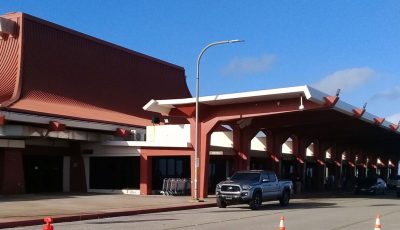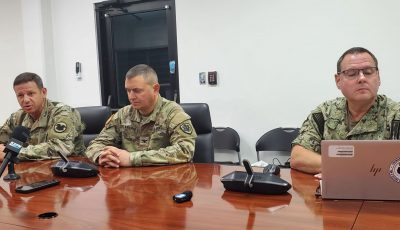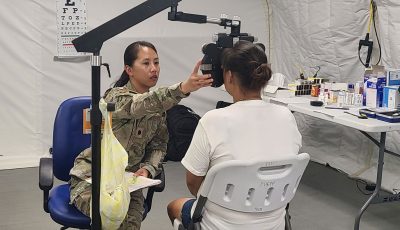DOD leads push for restricted airspace on Tinian
Restricted areas signaling “unusual, often invisible, hazards to aircraft”—like artillery or aerial fire—will inch closer to the Tinian airport if the Federal Aviation Administration deems the U.S. military’s proposals for these areas safe.
FAA Joint Order 7400.2k says a restricted area must exclude airspace 1,500 feet above ground level and below within a 3-nautical-mile radius of public airports.
The Department of Defense leads the push for the change to this order.
The CNMI Joint Military Training draft environmental impacts statement states that “it is assumed” that the FAA change to this order “will be approved as requested by [the military] in part, to support this proposed action” of restricted areas around Tinian.
The draft EIS details special use airspace, or SUA, inclusive of restricted areas and “military operations areas” as high as 30,000 feet. SUA is a must-have for live-fire training on Tinian to happen.
“The order states that a reduction to the 3-nautical mile exclusionary airspace surrounding Tinian International Airport may be approved by the [FAA] on a case-by-case basis after a risk-based analysis in accordance with the safety risk management process, and development of a risk resolution implementation plan,” the draft EIS says.
A meeting with the Marines Corps Forces Pacific and the Commonwealth Ports Authority yesterday did not provide a clear update on this rule making, it was learned.
What was mainly discussed was a Tinian airport layout plan, or ALP, inclusive of military infrastructure and activity on the north side of CPA’s property.
This needs to be accepted by CPA, and then submitted to the FAA for approval.
AECOM engineers, who designed the proposed ALP, were at the meeting.
CPA board members, U.S. Air Force and MARFORPAC officials, Environmental Protection Agency’s Carl Goldstein, and Marianas Visitors Authority’s Perry Tenorio were at the meeting.
FAA representative Tom Sylva declined to comment on where the FAA was on the rule making at the meeting’s end.
Sylva instead referred to MARFPORPAC operations officer Tim Robert, who said their proposal for special use airspace is “in its final draft stage in preparation for submission to the FAA.”
But he clarified that this was separate from the FAA rule making. “This is a standard special airspace proposal, with a standard process,” he said.
“FAA is and has previously been in the process of reviewing and amending one of their internal regulations—but that’s not part of our special use airspace or special use airspace proposal process. That’s a total[ly] separate internal FAA matter.”
The rule is regarding how close an SUA can be established within proximity of a commercial civilian airport, he said. “That has nothing to do with military use of the airport, or military training. It’s about an internal FAA regulation that previously stated three miles was the limit… FAA is internally reviewing that to make sure if that still makes sense or doesn’t.”
“Bottom line, it’s either safe or it’s not, and that’s an FAA determination,” he added.
According to the FAA, special use airspace is normally designated to support DOD requirements. The FAA explains that a past memorandum of understanding with DOD details the impact analysis of special use airspace. This understanding designates when DOD is the lead agency and when FAA is the cooperating agency for federal compliance with rules.
The ALP
Sources within the meeting said a concern was brought up on the impact to commercial “flight paths when live-fire ranges are turned on.” The military has reassured that those concerns have been noted. They meet with local carrier Star Marianas today.
It was also gathered that the co-use of the military’s aviation fuel at the airport was also discussed as a possible benefit to CPA. The military had suggested previously that this could be shared.
But yesterday, they deferred to the Defense Logistics Agency—which is known for buying fuel—for a method to sell or share this fuel with CPA.
Robert described the meeting as more informational, highlighting discussion about navigational aids and air traffic control tower requirements and radar requirements to ensure safety.
They are “working to come up with a solution,” he said. A Tinian ALP is “constant” in all proposed training alternatives in the EIS, he noted.
The buildup focuses on the north side of Tinian as CPA previously directed. But that does not eliminate the Air Force alternatives for the southern side, Robert clarified.
“Could be north, could be south,” he said. “CJMT is north, and that includes divert on the north, but that does not preclude Air Force from doing divert [activity] on the south,” he said.
CPA executive director Maryann Lizama said the meeting went well. “They shared their draft ALP,” she said.
“CPA would like to see some other things incorporated” like navigation aids, control towers, and instrumental landing systems that are “usually situated in an airfield,” she said.



























